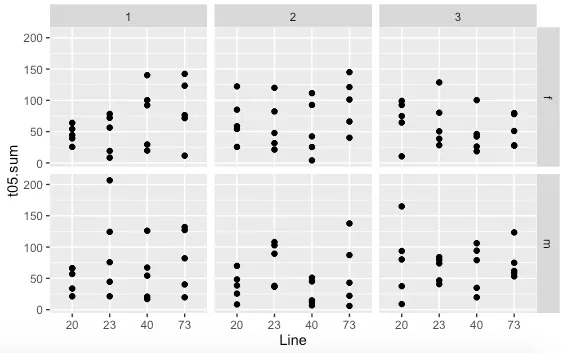我正在尝试向我的ggplot中添加一条lm线,代码如下:
# RING data:
#### Read data & Converting factors ####
dat <- read.table("RING R kopi.txt", header=TRUE)
str(dat)
dat$Vial <- as.factor(dat$Vial)
dat$Line <- as.factor(dat$Line)
dat$rep <- as.factor(dat$rep)
dat$fly <- as.factor(dat$fly)
str(dat)
datSUM <- summaryBy(t05+t10+t15+t20+t25+t30~rep+Conc+Sex+Line+Vial,data=dat, FUN=sum)
fl<-levels(datSUM$Line)
datA <- droplevels(datSUM[datSUM$Conc=="a",])
datB <- droplevels(datSUM[datSUM$Conc=="b",])
datC <- droplevels(datSUM[datSUM$Conc=="c",])
datD <- droplevels(datSUM[datSUM$Conc=="d",])
datE <- droplevels(datSUM[datSUM$Conc=="e",])
datX <- droplevels(datSUM[datSUM$Conc=="x",])
datY <- droplevels(datSUM[datSUM$Conc=="y",])
c <- ggplot(Line, t05.sum, data= datA, facets=Sex~rep)
c + stat_smooth(method=lm, fullrange = TRUE) + geom_point()
脚本运行了但没有添加任何行,我还尝试使用:
c + stat_smooth(method=lm) + geom_point()
c + stat_smooth(method=lm, fullrange=TRUE, alpha = 0.05) + geom_point()
c <- qplot(aes(y=Line, x=t05.sum), data= datA, facets=Sex~rep)
c + stat_smooth(method=lm, fullrange = TRUE) + geom_point()
结果:
 数据集的子集:
数据集的子集:请注意,这是一个R代码段,其中包含一个数据框。该数据框具有6列和25行,并且每列都是因子变量。每一行代表一个实验测量值。以下是每个列的详细信息:
- rep:重复次数(1、2或3) - Conc:化合物的浓度(a) - Sex:参与实验的性别(f表示女性,m表示男性) - Line:参与实验的动物品系编号(20、23、40或73) - Vial:存储样本的瓶子编号 - t05.sum、t10.sum、t15.sum、t20.sum、t25.sum和t30.sum:测量结果
请注意,这些结果是在不同时间点(5、10、15、20、25和30分钟)测量的。
dput()。 - mtoto